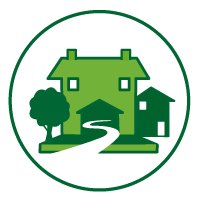Sustainability
TREADING LIGHTLY ON THE EARTH
Reducing both its waste and carbon footprint have been joint aims for the Threshold Centre since its inception in 2004. The building project at that time enabled a complete assessment of available alternatives and their application to the site.
Now that addressing climate change has become a global priority, it is more important than ever that we set an example of sustainable living. Threshold actively supports local environmental groups, while a working group of residents meets regularly to determine how we can further reduce our impact, both as a community and as individuals.
A major consideration as a cohousing community is the use of energy and water in all the buildings. The ways in which we minimise that use are described below, together with other measures that we have adopted to enhance Threshold’s sustainability. Awareness is the key.
Growing Our Own Food
The vegetable garden uses compost produced on site and locally sourced manure, and rainwater collected from guttering along members’ houses and two polytunnels. Threshold gardeners primarily use organic methods, while a few also aspire to permaculture and ‘no-dig’ principles. Produce is used by all residents, particularly for communal meals and events, while any excess is processed, stored and frozen.
Biodigester
All wastewater is treated on site. Two of Threshold’s cottages use the original septic tank but the remaining households are connected to a central biodigester, which produces clean water that is discharged into an adjacent stream.
Energy
Six photovoltaic arrays have been installed on roofs across Threshold’s residential site, including our communal farmhouse; additional electricity comes from a green energy supplier.
Biomass Heating
The whole site is served by a wood-pellet biomass boiler, which provides hot water and heating for all the homes. A few of the older cottages are not so well insulated, so wood burning stoves have been installed for additional heat.
Eco Homes
Two barns and several holiday cottages on the residential site were converted and renovated to high standards of heat and sound insulation/passive solar gain, achieving high eco-home ratings. Other existing buildings, comprising five older cottages and the farmhouse, are gradually being brought up to modern standards through the addition of double glazing, draft proofing, insulation and so on.
Rainwater Collection
Rainwater is collected for use in the shared laundry and in the gardens. On Threshold’s “new-build” homes, rainwater harvesting is maximised through the use of a complete system that includes guttering on all buildings, existing drains and soakaways, and three large water-storage tanks. A separate tank is situated outside the communal laundry, where it is connected to the washing machines so that they can run on rainwater. Rainwater is also harvested in butts from the gutters running along most of the other buildings.
Transport
Given Threshold’s rural location, we recognised that some residents would need their own transport, to get to work and so on. However, we stipulate that members are permitted only one car per household; and, whenever possible, we car share to reduce the volume of harmful emissions released.


